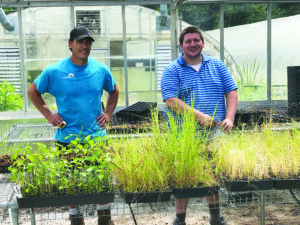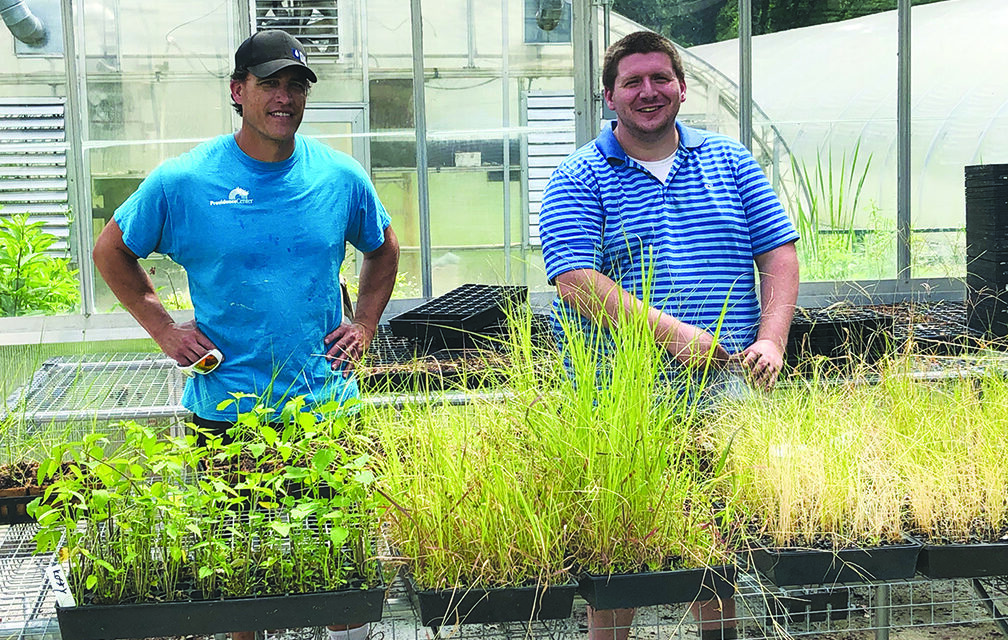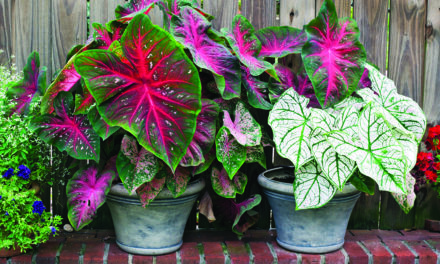
Nathan Ullrich, left, with fellow Arnold resident Patrick Andreoli work at a table at the Providence Center in Anne Arundel County, potting a variety of bay grasses to help restore the Maryland shoreline. Many of the plants are placed in organic containers composed of plant material that will simply become part of the soil where the grasses have been inserted, adding to the quality of the soil and the growth of the plant. (Photo by Micheal Rhian Driscoll)
During the COVID-19 quarantine, many homebound dwellers revisited the friendly confines of their own backyards with renewed appreciation.
But over the past 15 years, Dr. Douglas W. Tallamy has been a nonstop force of nature trying to reach as many people as possible, teaching what precious resources those homegrown plots of land truly are.
A prominent University of Delaware entomologist studying insects for 40 years, with numerous research papers to his credit, his latest book, Nature’s best hope: a new approach to conservation that starts in your yard (Timber Press, 2019), is aimed at a wider public audience. In it, Tallamy expands on the innovative idea for creating a “homegrown national park” brought to light in his first popular publication, Bringing nature home: how you can sustain wildlife with native plants (Timber Press, 2009).
Both reflect his view that, while stand-alone National Parks are great, they are, in fact, isolated islands, representing just a fraction of the dedicated space needed to effectively preserve our endangered environment. To summon the call for a more widespread, interconnected approach, Tallamy speaks several times a week via lecture and media interview, hoping to inspire individuals to convert part of their yards, gardens, and even container florae from the primarily ornamental to attractive but also helpful plants — those that nurture beneficial bugs and birds by creating healthy “food webs” throughout neighborhoods.
Tallamy explained that he “stumbled” upon this concept years ago after viewing a map showing 40 million U.S. acres dedicated to lawns — what he considers a sterile landscape or dead zone–while National Parks make up roughly half that amount, or 20 million acres.
Recognizing that manicured lawns have anchored the cultural and pragmatic aesthetic of home landscapes for the last 100 years, he points out that lawns are little better for the environment than pavement, contributing damaging water and fertilizer runoff. Traditional lawn and yard maintenance accounts for 10 times the amount of pesticides used in agriculture, Tallamy added.
Ideally, landscapes contain four main elements providing sustainable relationships with the natural world, he advised: 1) support a viable food web (think spreading spider web rather than linear food chain), 2) help manage the watershed, 3)sequester carbon (intake rather than output, represented when dark brown soil is produced) and 4) pollinator attraction. Lawns do none of these things, Tallamy said.
Another study he cited shows that 80 percent of suburban landscape plants are composed of Asian ornamentals, such as crape myrtle and gingko trees, whose leaf chemistry leaves local insect on a starvation diet.
“Bugs find their host plant by chemistry. It smells right, it tastes right,” he said. “A yard with nothing but Asian varietals means leaves local insects unable to physically able to process the leaves as a food source.”
The answer, Tallamy suggests, is not necessarily eliminating the entire lawn, but converting at least a portion to native shrubs, trees, and plants. Instead of uprooting all ornamentals, try diversifying, maybe. And, while native plants are better, what he termed “keystone” plants are best.
“Ninety percent of insect herbivores are diet specialists rather than generalists,” Tallamy said. The keystone plants successfully provide sustenance for the greatest number of these. Towering above them all is the mighty oak.
Grown economically from a single acorn, oak trees are sustainable in 84 percent of counties nationwide, he stated. A Philadelphia area study showed oaks supporting 557 species of caterpillar, a crucial food source for many birds, including the Chickadee, which needs 6000 caterpillars to feed its young. Another study indicated 80 percent of native bees consume oak pollen. (While the predicament of honeybees is more widely known, 4,000 native bee species also require pollinator support, Tallamy noted.)
Four more genera considered keystone natives are Goldenrod, Native willow (perfect for hedges), Sunflower and Aster, with each supporting at least 40 species of native insects.
Tallamy likens this keystone approach to building a home: you build the foundation, beams, and supports first, before the decorative wallpaper, he explained.
Tallamy prefers taking a “carrot” rather than a “stick” approach to instituting these changes, which is one reason he writes and speaks so prolifically, hoping to inspire change at the grass roots level. If garden centers and landscapers hear requests for sustainable natives enough, more than décor-friendly plants will become more widely available, he suggested.
Asked whether there is reason to hope that his idea for a homegrown national park is beginning to resonate, Tallamy replied that an interview request from a publication based on the uber traditional Eastern Shore bodes well that it may take root.






